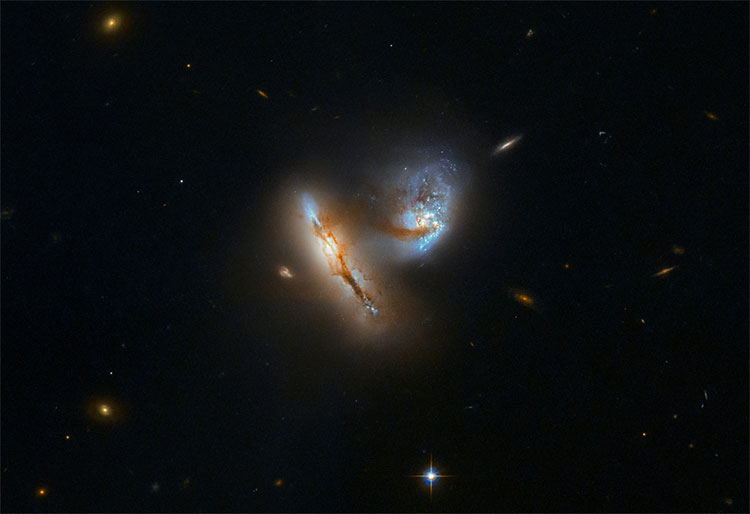Two collision galaxies are 424 million light-years from Earth
Hubble Space Telescope captures a pair of galaxies that are about to merge to form a new galaxy called UGC 2369.
The two galaxies looked like they were dancing due to gravity pulling them close together, Space reported on August 18. Scientists named the galaxy pair UGC 2369 , about 424 million light-years from Earth. The light year is the distance traveled by light in a year, nearly 10 trillion kilometers.

Hubble pair of UGC 2369 galaxy telescope shots.(Photo: NASA / ESA).
These two cosmic stars, gas and dust collects so closely that faint bridges appear in the space between them. Interaction with other galaxies is a common occurrence in the history of most galaxies, according to the European Space Agency (ESA). For large galaxies like the Milky Way, most interactions involve smaller objects called dwarf galaxies.
However, every few billion years, a more significant event may occur. For example, the Milky Way will collide with Andromeda, the giant "neighbor" galaxy. It is likely that solar-like star systems are not significantly affected, but if viewed from a distance, you will see two galaxies gradually merging for 4 billion years. ESA named this new galaxy Milkomeda .
Nearly 30 years of operation, the Hubble Space Telescope captures many valuable images of galaxies in the universe. Some photos even help scientists "look back" in the past, showing objects formed just after the Big Bang, an explosion that marked the birth of the universe 13.8 billion years ago.
- The collision with the galaxy is 350 million light-years from Earth
- Detecting exotic galaxies, about 359 million light-years from Earth
- Andromeda galaxy will destroy the Earth
- The galaxy deforms 100 million light-years from Earth
- Unique picture of 2 galaxies colliding
- The collision of the galaxy is 80 million light-years from Earth
- The battle between galaxies in the universe
- How far can we stand from the Earth, can we see living dinosaurs?
- Discovered the galaxies about 10,000 million light-years from Earth
- Has the diverse ecosystem on Earth been born from planetary collisions?
- New Hubble telescope image of the hybrid galaxy UGC 12591
- The moon is 95 million years later than the solar system
 Van Allen's belt and evidence that the Apollo 11 mission to the Moon was myth
Van Allen's belt and evidence that the Apollo 11 mission to the Moon was myth The levels of civilization in the universe (Kardashev scale)
The levels of civilization in the universe (Kardashev scale) Today Mars, the sun and the Earth are aligned
Today Mars, the sun and the Earth are aligned The Amazon owner announced a secret plan to build a space base for thousands of people
The Amazon owner announced a secret plan to build a space base for thousands of people